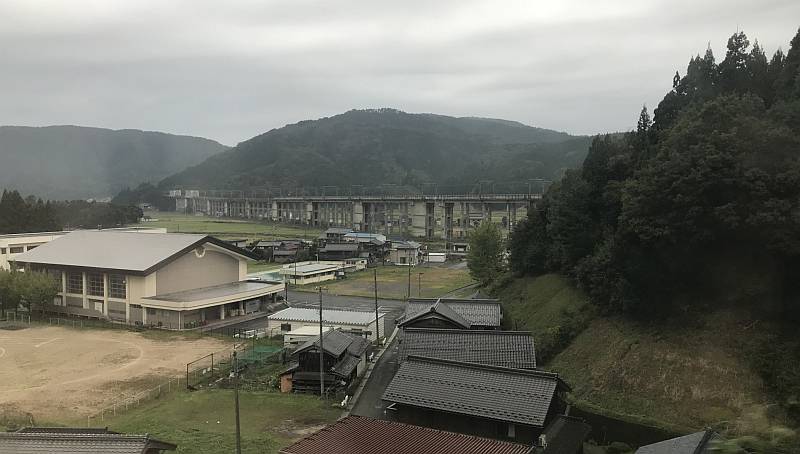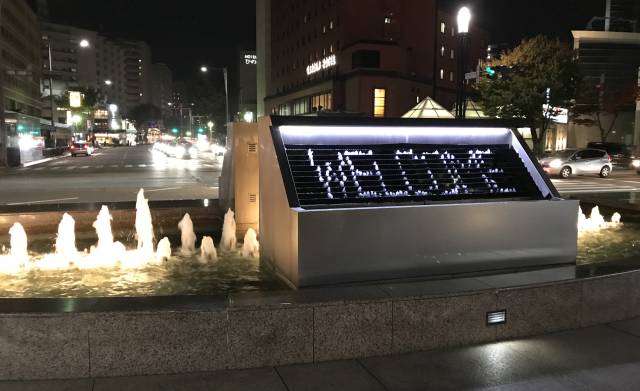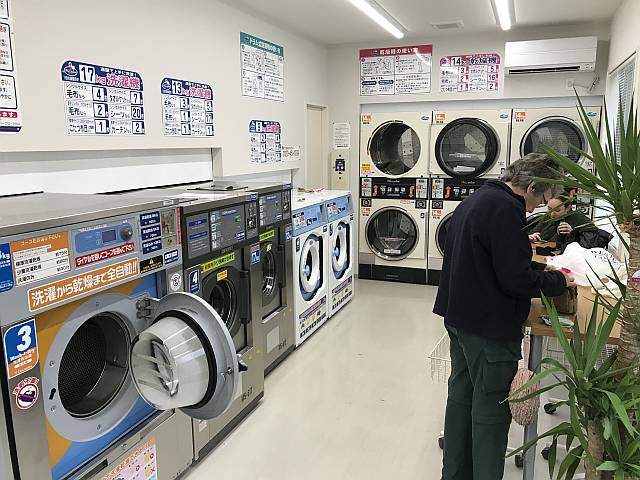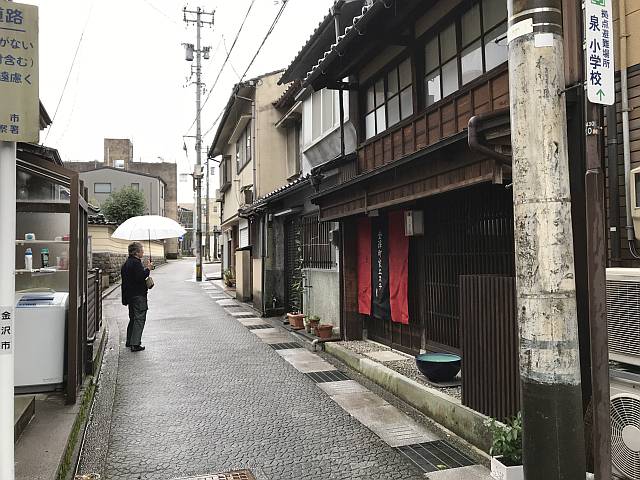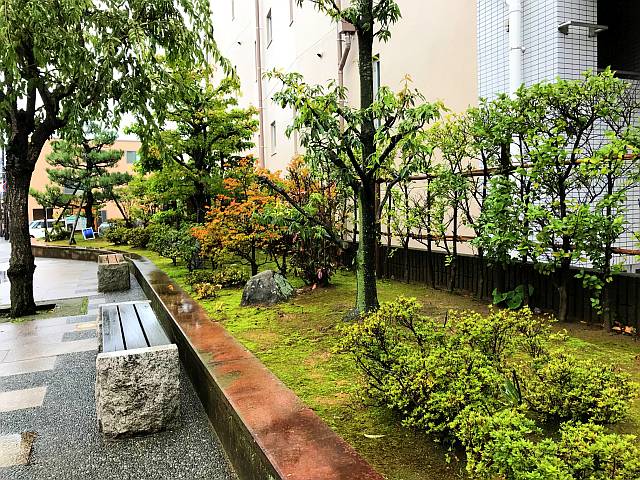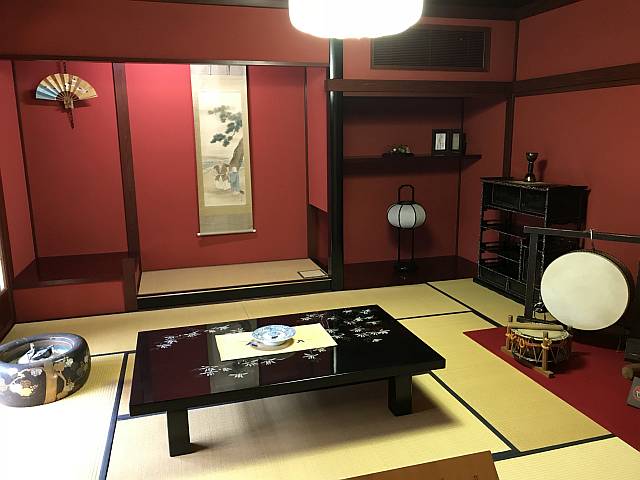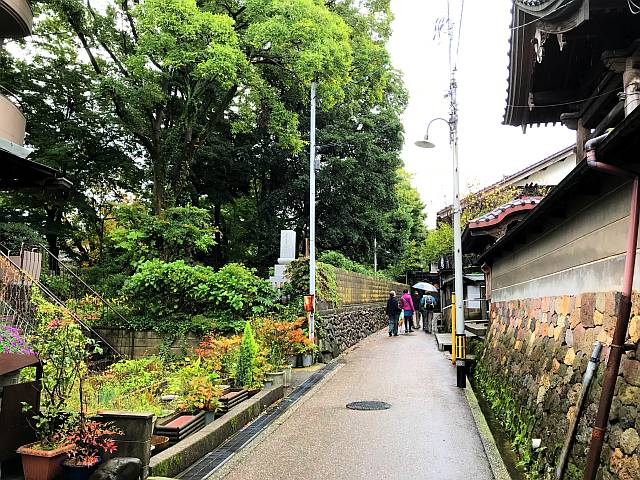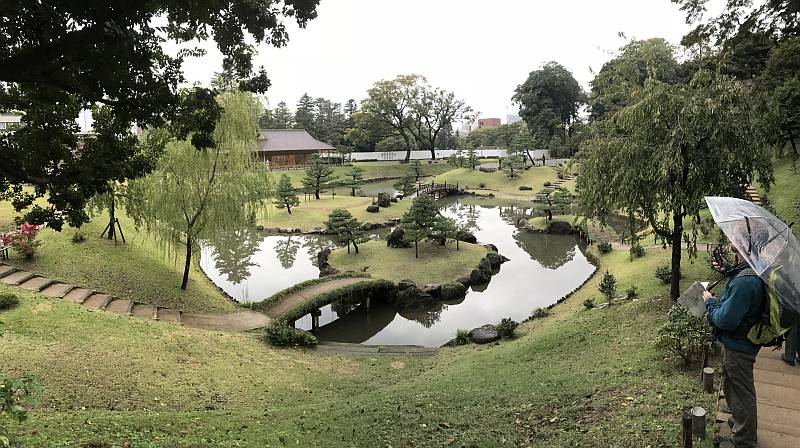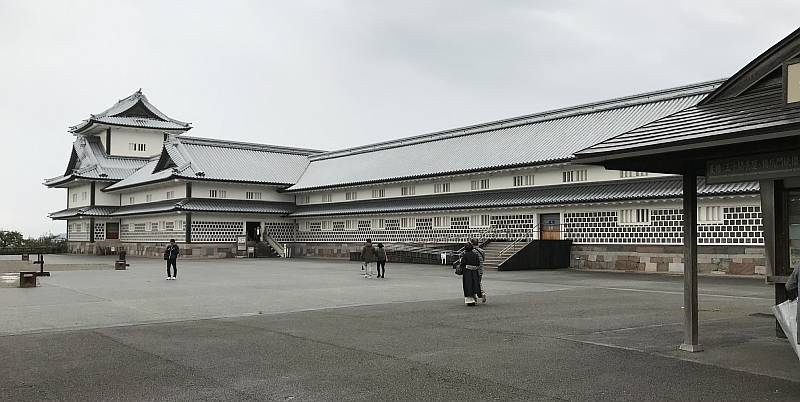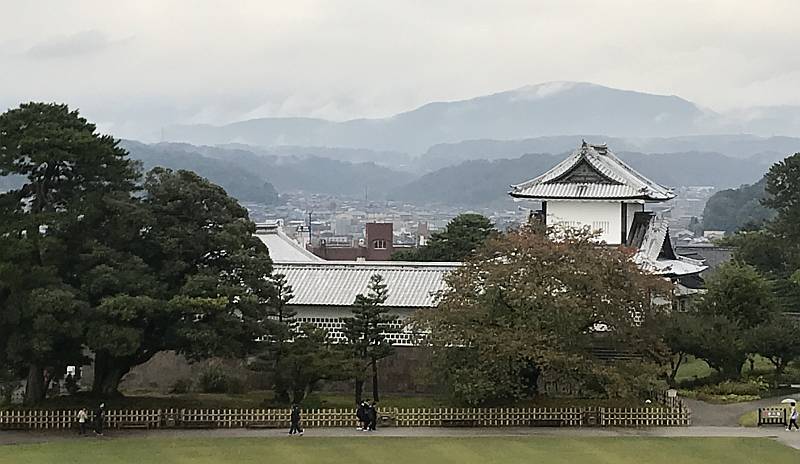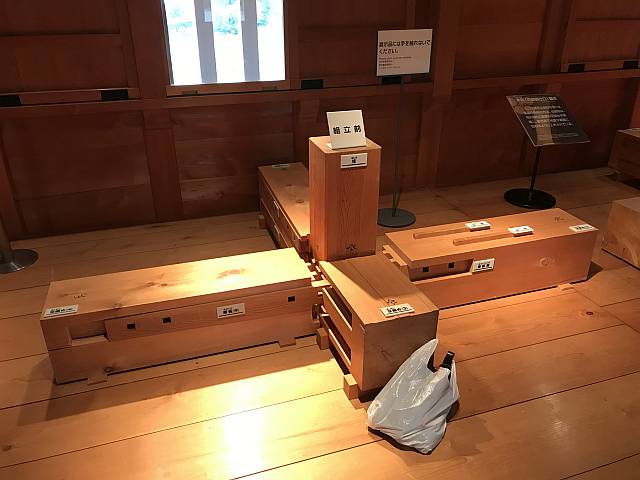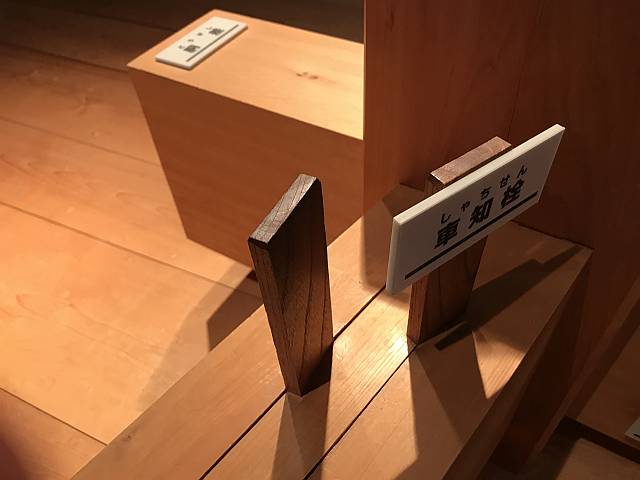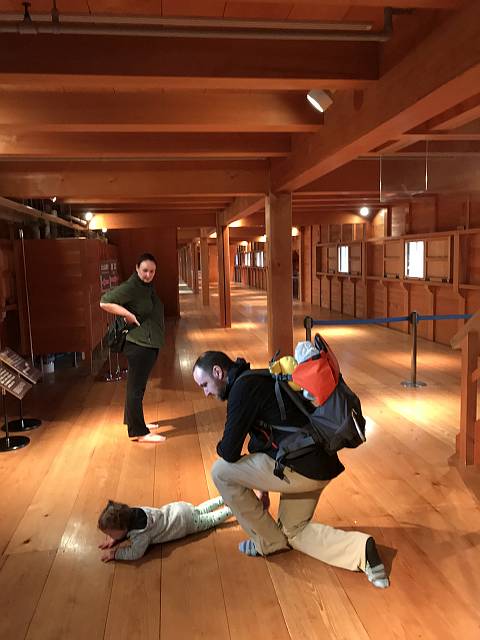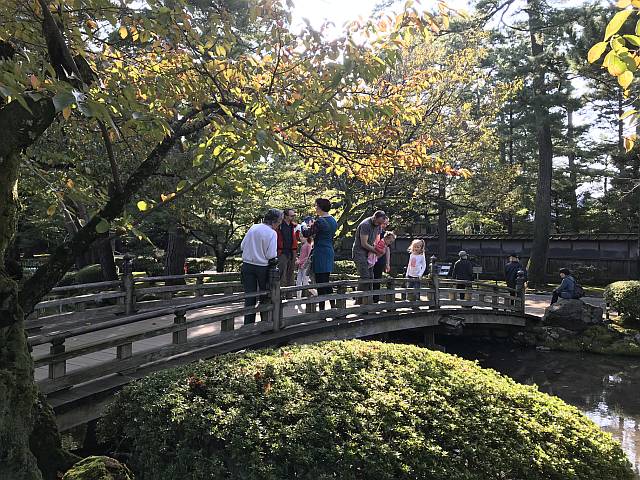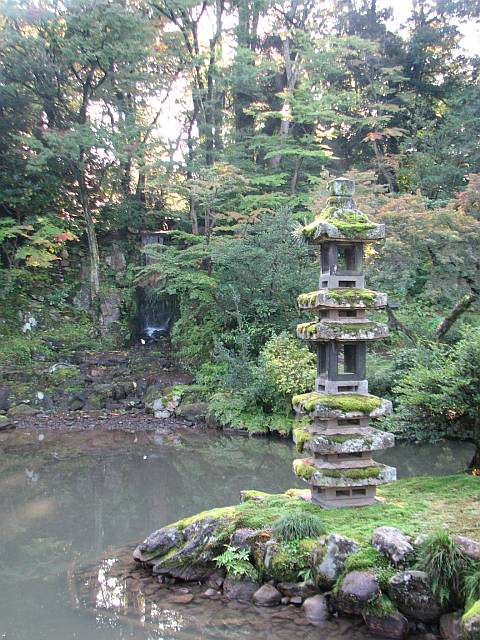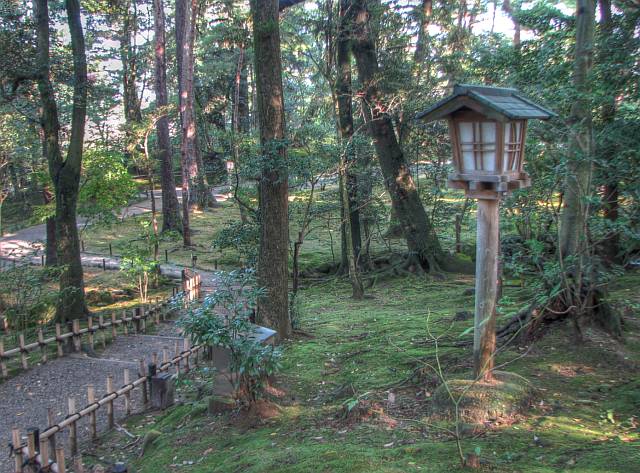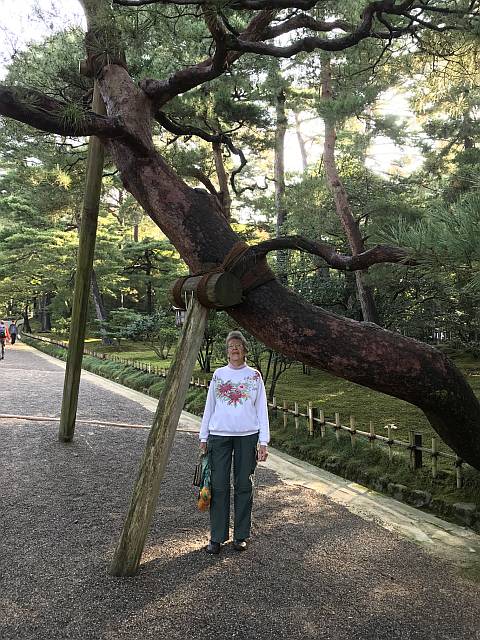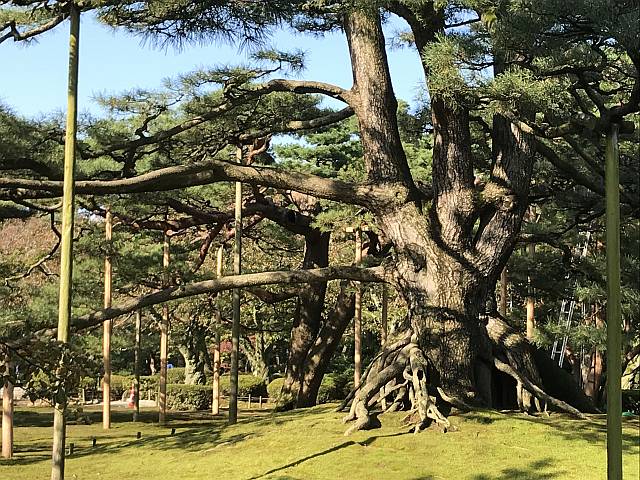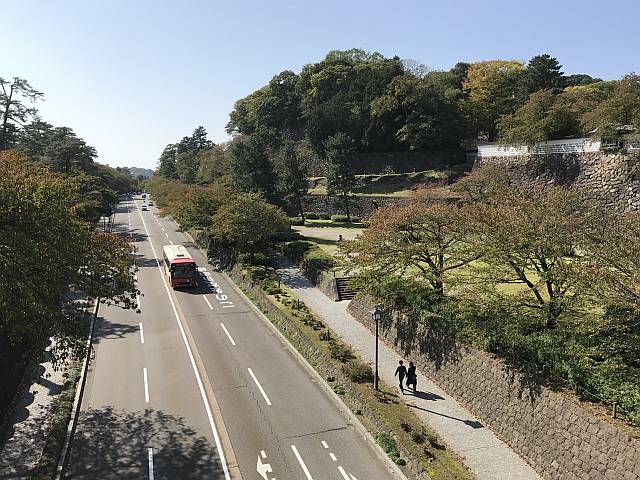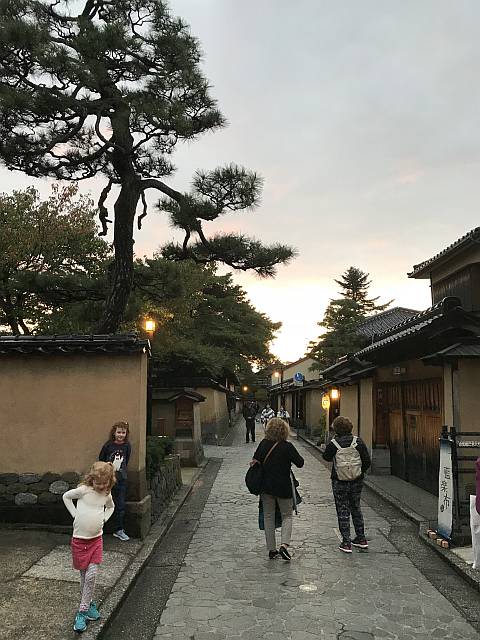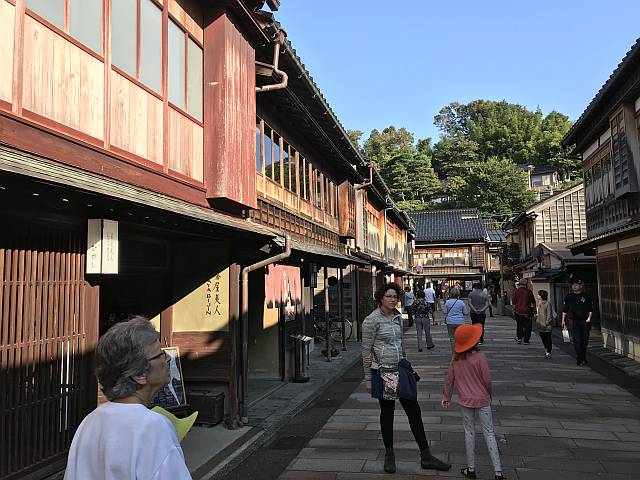The gate sculpture in front of the Kanazawa railway station.
I was very impressed with this and intended to get some more photos in the daylight, but when we left Kanazawa I somehow didn't get time.
Our group can be seen on the left, heading for the nearby bus station.
Kanazawa, like Hiroshima, didn't have a subway system.
Photo taken 2017/10/24
This photo was taken from one of the trains that took us from Hiroshima to
Kanazawa (Shinkansen to Osaka, an express train called The Thunderbird from
Osaka to Kanazawa; I think this would have been on the second part of that
journey).
Our train was moving toward the right.
I thought that we might turn onto the elevated line across the valley, but
in fact we went onto another line that went straight ahead.
To me there are several things that this pretty ordinary photo show:
- Typical Japanese countryside, flat developed land and steep, forested
hills;
- The flat land is part agricultural, but also has many buildings
(agricultural land with no buildings in sight is practically non-existent);
- The train is about to enter a tunnel; Japanese trains seem almost always
about to enter tunnels (and often just emerging from tunnels too);
- The elevated railway is inelegant (compare to next photo).
Photo taken 2017/10/24
This photo was taken eight minutes after the previous one.
The contrast in the aesthetics of the two bridges is striking (this bridge
is for road traffic, so it wouldn't have to carry the weight of the
other bridge which was for trains).
Photo taken 2017/10/24
A very innovative fountain at Kanazawa main railway station.
Small jets of water, illuminated by a bright light shining across the surface
of the installation, act like a digital display.
It showed the time as well as 'Welcome'.
Photo taken 2017/10/24
The laundromat within easy walking distance of our AirBnB accommodation.
Most, if not all, of the AirBnB places we stayed had washing machines, but
Denece tells me that most were not much good at drying the washing.
(While we all would prefer to use natural air drying for washing – for
environmental reasons – it was simply not practical for the wet climate
and tight time constraints of Japan.)
Laundromats and supermarkets were usually quite close to our accommodation.
We used AirBnB everywhere except the first night at Narita View Hotel.
Photo taken 2017/10/25
A slippery-dip with a difference; or should it be called a rollery-dip.
I'd worry that little fingers might get between the rollers, with very
unhappy consequences; but one has to suppose that it has stood the test of
time.
Across the road from the laundromat.
You can see that the weather has been wet again (or should that be 'still'
rather than 'again'?)
Photo taken 2017/10/25
Denece and I loved the narrow back streets and Japanese domestic
architecture.
Photo taken 2017/10/25
Another back street of Kanazawa, this one paved with granite slabs.
Photo taken 2017/10/25
Making the most of a little space between a street and buildings.
I love the use of stone that I saw in Japan; whether natural (as the boulder in the garden), or semi-natural (as the block on the end of the bench) or cut slabs (as the paving) and the rounded gravel beneath the seats.
Links to other uses of stone in Japan are in the
Index.
Photo taken 2017/10/25
Our group (from left, Beth, Anna, Julia, Shayne, Ken, Adie (in pusher), Claire
and Denece, in front of the AirBnB house that we had for three nights.
It was very nice and by far the cheapest accommodation that we had in Japan;
perhaps because Kanazawa is a less popular tourist destination than the other
places we visited?
The house was on a side street close to Nishi Inter-Odori.
Photo taken 2017/10/25
A museum in the
Nishi Chaya District dedicated to author Seijiro Shimada.
Whether or not he lived in this house I don't know, but this traditionally
decorated room is well worth a photo!
The museum and many other very interesting things (including temples seemingly
without number) were within easy walking distance of our AirBnB house).
Photo taken 2017/10/25
Yet another beautiful narrow Kanazawa street.
Note the three very different types of wall, and the algae growing on what
must be a continuous seepage of water on the lower part of the wall on the
right.
Streets like this are made (both literally and figuratively) for walking.
Still an umbrella; I think that this was getting toward the end of the latest
lot of rain.
Photo taken 2017/10/25
We had lunch at this place and we could cook our own food at our table.
The lady was quite happy to let Shayne cook his meal – she relised he
knew what he was doing.
Photo taken 2017/10/25
When I started cooking my lunch the lady could see that I had no idea, so
she very kindly took over.
Shayne, Denece and I ate at this place, Julia took her kids to MacDonalds.
Poor Julia!
Photo taken 2017/10/25
A clever sculpture of a three dimensional model of central Kanazawa, including
the hill on which were the gardens and castle.
Photo taken 2017/10/25
Gyokusen-inmaru Garden; a part of
Kanazawa Castle Park.
As I recall we took part (if that's the right phrase) in a traditional
Japanese tea ceremony in the tea-house on the left.
Photo taken 2017/10/25
One side of the central building of Kanazawa Castle.
The central building (keep? tower?) was very different to those of Osaka,
Himeji and Hiroshima.
Photo taken 2017/10/25
The other side of the central building of Kanazawa Castle.
Photo taken 2017/10/25
Some of the castle walls in the Castle Park.
It seemed that there had been some substantial changes made in the landscaping
of the Castle Park, and probably rebuilding of partly demolished walls?
Photo taken 2017/10/26
A view from the top of Kanazawa-jo
Photo taken 2017/10/25
The most striking feature of the interior of Kanazawa Castle was the
timber-work.
Photo taken 2017/10/25
A wooden model of a section of the castle
Photo taken 2017/10/25
A full-scale model of a join between five beams, as used in the castle.
Photo taken 2017/10/25
The two small pieces of timber protruding from the horizontal beam show
how the joins were locked into place.
With these pieces in place the centre of the three main parts of the join
would not be able to pull out toward the right.
Photo taken 2017/10/25
Two-year-olds can get too much of sight-seeing.
Adie is having a melt-down!
Photo taken 2017/10/25

